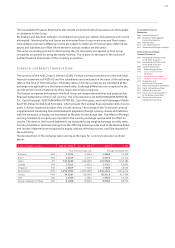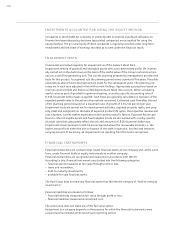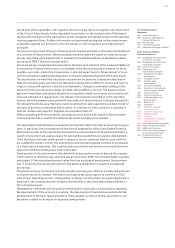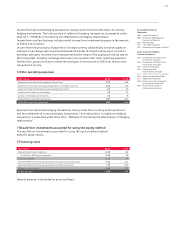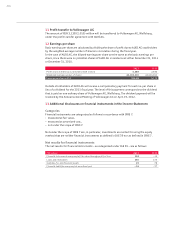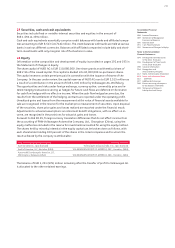Audi 2011 Annual Report Download - page 214
Download and view the complete annual report
Please find page 214 of the 2011 Audi annual report below. You can navigate through the pages in the report by either clicking on the pages listed below, or by using the keyword search tool below to find specific information within the annual report.
211
Consolidated Financial
Statements
188 Income Statement
189 Statement of Recognized
Income and Expense
190 Balance Sheet
191 Cash Flow Statement
192 Statement of Changes in Equity
Notes to the Consolidated
Financial Statements
194 Development of fixed assets
in the 2011 fiscal year
196 Development of fixed assets
in the 2010 fiscal year
198 General information
204 Recognition and
measurement principles
204 Recognition of income
and expenses
204 Intangible assets
205 Property, plant
and equipment
205 Investment property
206 Investments accounted for
using the equity method
206 Impairment tests
206 Financial instruments
209 Other receivables and
financial assets
209 Deferred tax
209 Inventories
210 Securities, cash and
cash equivalents
210 Provisions for pensions
210 Other provisions
210 Liabilities
210 Management’s estimates
and assessments
212 Notes to the Income Statement
218 Notes to the Balance Sheet
227 Additional disclosures
248 Events occurring subsequent
to the balance sheet date
249 Statement of Interests
held by the Audi Group
period and, where applicable, with regard to the discounting rate to be applied. Any impairment
of the Group’s leased assets is also dependent in particular on the residual value of the leased
vehicles after the expiry of the lease period, as this represents an essential portion of the expected
incoming payment flows. Further information on impairment testing and on the measurement
parameters applied can be found in the disclosures on the recognition and measurement
principles.
Carrying out impairment testing on financial assets requires estimates on the scale and likelihood
of occurrence of future events. Where possible, these estimates are based on historical values.
An overview of the value adjustments is included in the additional Notes to the Balance Sheet
according to IFRS 7 (Financial Instruments).
Provisions are also recognized and measured on the basis of an estimate of the scale and likelihood
of occurrence of future events and on an estimate of the discounting rate of interest. As far as
possible, use is also made of past experience or external expert reports. Measurement of provi-
sions for pensions is additionally dependent on the estimated development of the plan assets.
The assumptions on which the calculation of provisions for pensions is based are described in
Note 28. Actuarial gains and losses are reported in equity with no effect on income and have no
impact on the profit reported in the Income Statement. Changes to estimates relating to the
amount of other provisions are always recorded with an effect on income. The expected value
approach means that subsequent allocations are regularly made to provisions and unused provi-
sions are released on a regular basis. The release of provisions is recorded as other operating
income, while the expense associated with the creation of new provisions is directly allocated to
the relevant functional area. Warranty claims resulting from sales operations are determined on
the basis of previous or estimated future losses. An overview of other provisions is provided in
Note 30. Details with regard to litigation are provided in Note 37.
When calculating deferred tax assets, assumptions are required with regard to future taxable
income and the dates on which the deferred tax assets are likely to be realized.
The assumptions and estimates are based on premises that reflect the facts as known at any given
time. In particular, the circumstances at the time of preparation of the Consolidated Financial
Statements as well as the realistically assumed future development of the global and industry-
specific environment are used as a basis for estimating expected future business development.
Given that future business development is subject to various uncertain factors, some of which
are outside the Group’s control, the assumptions and estimates applied continue to be exposed
to a high level of uncertainty. This is particularly true of short and medium-term cash flow fore-
casts and of the discounting rates used in forecasts.
Developments in this environment that deviate from assumptions and are beyond the manage-
ment’s sphere of influence may cause the actual amounts to differ from the estimates originally
anticipated. If the actual development varies from the anticipated development, the premises
and, if necessary, the carrying amounts for the assets and liabilities in question are adjusted
accordingly.
The global economy continued to grow during the reporting year, albeit at a clearly reduced pace
during the second six months. The Audi Group expects the global upturn to continue in 2012
with a lower level of dynamism. Consequently, as things currently stand, no major adjustment is
expected in the carrying amounts of assets and liabilities in the Consolidated Balance Sheet in
the coming fiscal year.
Management’s estimates and assumptions were based in particular on assumptions regarding
the development of the economy as a whole, the development of automotive markets and the
development of the basic legal parameters. These aspects, as well as further assumptions, are
described in detail in the report on expected developments.




